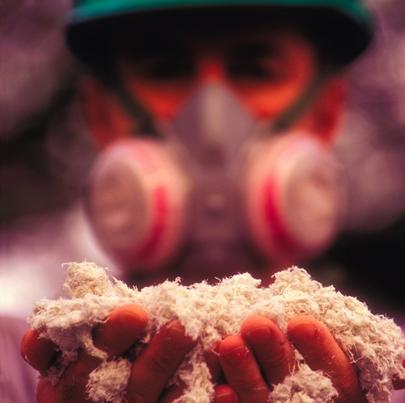According to the U.S. Occupational Safety and Health Administration, construction is one of the riskiest industries in America. More job-related deaths occur in this sector of industry than in any other trade or profession, as workers’ compensation lawyers in Chicago know.

Job-related deaths among construction workers fall into a number of categories, including all of the following:
- Falls, trips and slips
- Motor vehicle accidents
- Equipment strikes
- Electrocution
- Crushing injuries
- Exposure to chemical and mineral substances
Asbestos is one of the most common lethal substances encountered by construction workers.
What is asbestos?
Asbestos is a natural mineral with powerful insulating and fireproofing capabilities. Builders in the 19th and 20th century used it widely as a flame-resistant and heat-resistant material in construction. Scientists discovered in the 1960s that it was a factor in many severe and fatal illnesses among people who used it or worked in its presence. It has now been outlawed in the American construction industry, but people who work on older structures are still at risk.
How does asbestos hurt workers?
Asbestos is made of up tiny fibers. When workers breathe these fibers, they enter the lungs and become lodged there. The fibers can cause serious problems such as compromised lung function, lung carcinoma, asbestosis or a rare form of lethal cancer known as mesothelioma. According to the National Cancer Institute, approximately 28 percent of workers who performed recovery work at the site of the World Trade Center towers developed abnormal lung function. Asbestos had been used heavily in the construction of the towers. Mesothelioma cases are especially common among recovery and demolition workers exposed to asbestos.
What is mesothelioma?
Mesothelioma is an aggressive and deadly cancer that affects the delicate lining of the body’s organs. It was almost unheard of until builders began to use asbestos as an insulating material in the 19th century. Now it affects up to 30,000 workers every year, according to OSHA statistics. Mesothelioma can disable and kill a formerly healthy worker in only a few years. Other cases of mesothelioma develop gradually, with more than five decades elapsing between exposure to asbestos and the fatal diagnosis.
What is asbestosis?
Asbestosis is a severe inflammatory lung disease caused by exposure to asbestos. The tiny fibers lodge in the victim’s lungs, causing irritation and hardening of the lung tissues. In severe cases, asbestosis may progress to the point that the victim can no longer breathe. Decreased lung capacity causes disability and death.
Who is susceptible to damage caused by asbestos?
Many workers are susceptible to serious physical damage caused by asbestos, as workers’ compensation lawyers in Chicago are aware. A wide range of industries added asbestos to their construction materials over a span of more than a century. Anyone who works with these older materials is at risk. According to the U.S. Centers for Disease Control and Prevention, more than 1.5 million American workers face possible exposure to asbestos every year.
Which trades face the highest risk factors from asbestos?
Trades facing the highest risk factors include plumbers, insulation specialists, plasterers, drywall hangers, roofers and carpenters. Wrecking crews are at an elevated risk of asbestos exposure. Operators of bulldozers and cranes may also disrupt asbestos-containing structures and breathe the deadly fibers into their lungs.
Secondary hazards from asbestos can hurt families
The risk of asbestos exposure does not stop on the job site. Even if a person is not directly present while asbestos is handled, the fibers can spread widely. This contamination can affect a large number of uninvolved people.
Workers can carry asbestos dust on their tools, their skin, their clothing and their hair. Many families suffer adverse health consequences from secondary asbestos exposure. In extreme cases, family members have even developed cancer or asbestosis from fibers brought home by a worker.
Where is asbestos located?
According to the U.S. Environmental Protection Agency, there are currently 733,000 significant commercial and public buildings in the country. Many of these buildings were constructed during or before the 1960s. Of those older buildings, the great majority of them contain asbestos products, sometimes in lethal concentrations.
Asbestos may be present in all of the following locations:
- Spray-on insulation
- Floor tiles
- Roof coating
- Aluminum sheeting
- Steel columns
- Drywall
Asbestos in drywall is especially lethal because the fibers are loose and may be released into the atmosphere with little or no disturbance.
Many other construction substances may also include asbestos, such as duct tape, vermiculite, felts, textured paints and acoustic insulation. Some common brands of duct tape included up to 50 percent asbestos content, according to the Mesothelioma Center. Construction workers who are exposed to older buildings may be unable to avoid the risk of contact with asbestos.
Safety precautions for asbestos
If workers must come into contact with asbestos-containing materials, they should take proper safety measures. Precautions include respiratory protection, masks, filters, protective garments and gloves. Workers should also wash their hands and bodies thoroughly after contacting any material that might contain asbestos.
Help is available for asbestos victims
People who have contracted a disease after asbestos exposure have options. Many victims have received settlements or become the beneficiaries of trust funds from former asbestos companies. Workers are entitled to full compensation for lost wages, treatment, survivor support and other expenses. Speaking with workers’ compensation lawyers in Chicago may be helpful for employees who have been exposed to asbestos.







